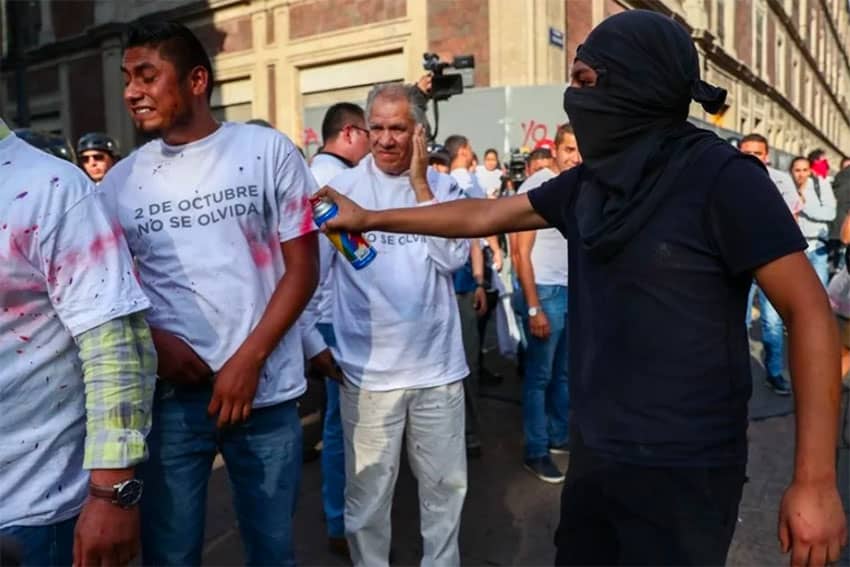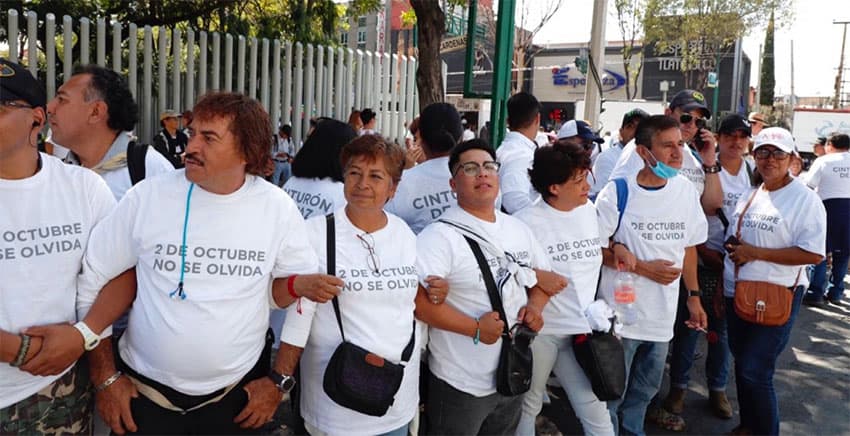More than 10,000 people marched in Mexico City on Wednesday to commemorate the 51st anniversary of the 1968 Tlatelolco massacre, during which at least 300 students were killed by government forces.
Members of more than 15 social organizations and public university students made up the bulk of the marchers who gathered yesterday afternoon at the Three Cultures Plaza, the scene of the slaying that occurred at a rally held amid social and political unrest 10 days before the opening of the Mexico City Summer Olympics.
The march left the plaza at 4:00pm bound for the zócalo, the capital’s central square.
About 12,000 Mexico City government workers lined the route to form a so-called cinturón de paz (peace belt), a strategy intended to prevent acts of violence and vandalism such as those that occurred during last week’s march for the 43 students who disappeared in Guerrero in 2014.
Almost all businesses that lined the route closed on Wednesday afternoon and some erected barriers to prevent the possibility of being targeted by radical protesters. Monuments, museums and most government buildings were also boarded up for protection and a plywood fence surrounded the Palace of Fine Arts.

The cinturón de paz, however, was unable to prevent a group of masked men and women from carrying out a vandalism spree whose commencement was marked by the explosion of a rocket on Eje Central, a major thoroughfare that runs through the historic center.
Self-styled anarchists proceeded to throw rocks at the Bank of México building located on the corner of Eje Central and Avenida 5 de Mayo and deface its façade with graffiti that denounced government involvement in past atrocities.
The masked individuals committed more acts of vandalism on the latter street, smashing glass at newspaper kiosks and street advertising as well as spray-painting anti-government slogans on storefronts or the barriers that protected them.
A small number of Molotov cocktails were also thrown in the direction of police officers, who didn’t patrol the march route but were present in large numbers on adjacent streets.
Shortly after, a rally commenced in the zócalo at which Felix Hernández Gamundi, a leader of the 1968 student movement, called for an end to impunity, demanding justice for the victims of the Tlatelolco massacre and other allegedly state-sponsored acts of violence.

“. . . We have to break with the state of impunity that the intellectual and material culprits of the 1968 massacre have enjoyed,” he said.
“. . . We don’t want another Ayotzinapa,” Hernández added, referring to the disappearance of the 43 students.
“. . . These incidents have kept repeating because the country hasn’t been capable of enforcing the law or justice in order to break impunity.”
At 6:10pm, the exact time that the 1968 massacre began, the names of all the victims were read out after which a minute of silence was held in their memory. A large contingent of police observed the rally while guarding the National Palace, which was damaged last week and has been targeted at previous Tlatelolco marches.
While the rally was taking place, masked radicals, most of whom were dressed completely in black, clashed with police in surrounding streets.
Police were verbally abused and attacked with stones and fireworks on one street before the instigators were repelled only to engage in another clash in a nearby street minutes later.

Three encapuchados (hooded persons) were detained by police but almost immediately released, the newspaper Milenio reported.
In a statement issued last night, the Mexico City government said “the objective of these groups was to provoke a scene of repression” in which police officers would use force against protesters, “which didn’t occur.”
Fourteen people were hurt during the clashes, most of whom were police officers who suffered only minor injuries, the statement said. However, three police were transferred to hospital for treatment.
Despite the acts of vandalism and aggression, the government described the deployment of the officials who formed the cinturón de paz as successful, asserting that they “contained the violence.”
Mayor Claudia Sheinbaum recorded a voice message that was disseminated among the officials in which she thanked them “infinitely” for their work.
“It’s very important civic work, we managed to contain the violence. I know that there were tense moments but you really are heroes . . .” she said.
Some of the officials, who work in either the Mexico City government or those of the capital’s 16 boroughs, complained to reporters that they were forced to attend the march and carry out security duties for which they are not trained.
Having been supplied with identical white t-shirts announcing they were part of the cinturón de paz, they were an easily-identifiable target for the radical protesters, some of whom used their spray paint on the shirts. El Universal reported today that the city government spent 960,000 pesos (US $49,000) to buy them.
At his morning news conference on Thursday, President López Obrador – who on Wednesday urged people to refrain from committing acts of violence and vandalism during the march – also praised the cinturón de paz and the majority of marchers who participated peacefully.
“I thank the citizens. . . for the good behavior yesterday in the march . . .” he said. “There were some incidents but not like last time . . .”
Source: El Universal (sp), Milenio (sp)
